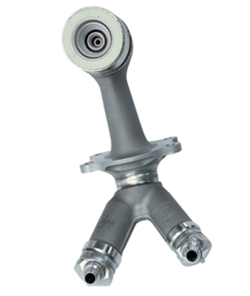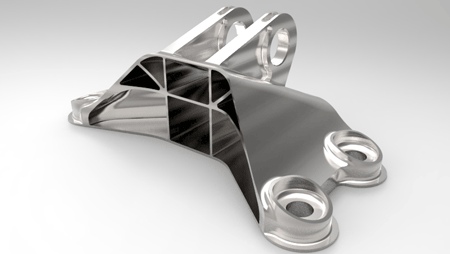Aero engine producers to accelerate introduction of Additive Manufacturing for engine parts
January 8, 2014
Rolls Royce plc, Derby, UK, is reported to be gearing up the use of Additive Manufacturing (AM) to produce components for its aero engines. According to Dr Henner Wapenhans, Head of Technology Strategy at Rolls Royce, AM technology is only a “few years away” from being used for engine parts in service.
Speaking to journalists in Dahlewitz, near Berlin, Dr Wapenhans recently gave the example of parts such as brackets which could be made lighter by AM but still retain the required mechanical properties of conventional manufacturing processes. He declined to give examples of other parts that could be produced by AM, but stated that it is more a question of individual parts that are ready to be released into series production, as opposed to large parts of an engine.
“Additive Manufacturing opens up new possibilities, new design space,” stated Dr Wapenhans, “You’re not constrained by having to get a tool in to create a shape. You can create any shape you like.” Another advantage is the slashing of long lead times normally associated with aerospace parts. “It can potentially take 18 months to get the first part after placing an order, versus Additive Manufacturing, which could be done quite rapidly in a week or less.”

Fig. 1 Each GE LEAP engine will contain 19 metal
fuel nozzles made by AM. The part is lighter and
more durable than traditional parts. Courtesy
GE Aviation
General Electric Aviation based in Cincinnati, Ohio, USA, which acquired two privately owned US companies involved in metal Additive Manufacturing in 2012, is also embarking on gearing up AM production efforts. The company plans to produce thousands of AM fuel nozzles using a cobalt-chromium alloy powder for its newest LEAP jet engine developed jointly with SNECMA in France.
The new LEAP engines are due to go into service late 2015 or early 2016 with over $22 billion of advance orders already in place. Each engine will use up to 20 AM fuel nozzles (Fig. 1) and GE will need to make around 25,000 nozzles annually within three years.
GE chose additive manufacturing for the nozzles because it uses less material than conventional techniques which would require welding about 20 small pieces together. AM reduces GE’s production costs and, because it makes the parts lighter, yields significant fuel savings for airlines.
GE’s commitment to AM is expected to see a tripling of its current 70 personnel at the AM facility in Fairfield, USA. The present facility has 35 AM machines from EOS GmbH and Arcam AB, and is testing equipment from 3D Systems and Concept Laser GmbH. Greg Morris, Business Development Leader for AM, and previously owner of Morris Technologies acquired by GE in late 2012, stated that the existing machines would not be efficient enough to meet demand for the fuel nozzles and that GE would have to buy 60 to 70 AM machines to achieve its targets. However, the company expects new AM machines now being developed to have three to four times the production capacity of existing ones.
The supply of advanced alloy powders and development of specialised design software is an area of concern however, and GE is said to welcome the opportunity to guide the growth of the supply industry through possible joint ventures or other investments. “There doesn’t exist a supply chain out there right now for this kind of work,” Morris added, “GE has to be involved in developing it.”
Other divisions of GE, together with its competitors, are said to be watching closely. GE Power & Water, which makes large gas and wind turbines, has already identified parts it can make with the AM process and GE Healthcare has developed a method to print transducers, the expensive ceramic probes used in ultrasound machines. “It’s really fundamentally changing the way we think about the company,” stated Mark Little, GE’s Chief Technology Officer.

Fig. 2 GE Aviation recently challenged the additive manufacturing community to redesign a titanium aircraft engine bracket and received hundreds of entries from 56 countries. The winning part designed by M Arie Kurniawan is shown above. The original bracket weighed 2033 grams (4.48 pounds), but Kurniawan was able to slash its weight by nearly 84% to just 327 grams (0.72 pounds) (Courtesy GrabCad)















